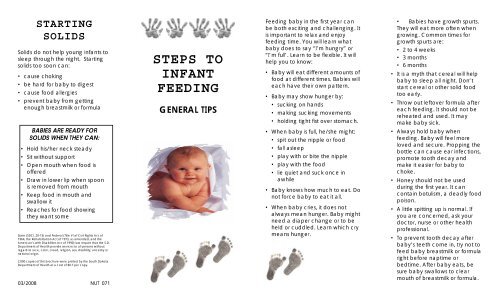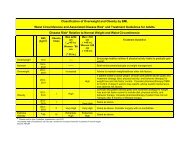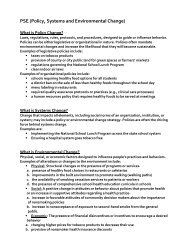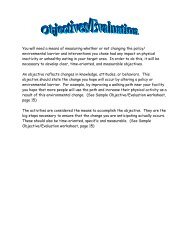General Tips For feeding Infants - Healthy South Dakota
General Tips For feeding Infants - Healthy South Dakota
General Tips For feeding Infants - Healthy South Dakota
Create successful ePaper yourself
Turn your PDF publications into a flip-book with our unique Google optimized e-Paper software.
STARTING<br />
SOLIDS<br />
Solids do not help young infants to<br />
sleep through the night. Starting<br />
solids too soon can:<br />
• cause choking<br />
• be hard for baby to digest<br />
• cause food allergies<br />
• prevent baby from getting<br />
enough breastmilk or formula<br />
BABIES ARE READY FOR<br />
SOLIDS WHEN THEY CAN:<br />
• Hold his/her neck steady<br />
• Sit without support<br />
• Open mouth when food is<br />
offered<br />
• Draw in lower lip when spoon<br />
is removed from mouth<br />
• Keep food in mouth and<br />
swallow it<br />
• Reaches for food showing<br />
they want some<br />
State (SDCL 20-13) and Federal (Title VI of Civil Rights Act of<br />
1964, the Rehabilitation Act of 1973, as amended, and the<br />
American’s with Disabilities Act of 1990) law require that the S.D.<br />
Department of Health provide services to all persons without<br />
regard to race, color, creed, religion, sex, disability, ancestry or<br />
national origin.<br />
2.000 copies of this brochure were printed by the <strong>South</strong> <strong>Dakota</strong><br />
Department of Health at a cost of $0.7 per copy.<br />
03/2008 NUT 071<br />
STEPS TO<br />
INFANT<br />
FEEDING<br />
GENERAL TIPS<br />
Feeding baby in the first year can<br />
be both exciting and challenging. It<br />
is important to relax and enjoy<br />
<strong>feeding</strong> time. You will learn what<br />
baby does to say “I’m hungry” or<br />
“I’m full’. Learn to be flexible. It will<br />
help you to know:<br />
• Baby will eat different amounts of<br />
food at different times. Babies will<br />
each have their own pattern.<br />
• Baby may show hunger by:<br />
• sucking on hands<br />
• making sucking movements<br />
• holding tight fist over stomach.<br />
• When baby is full, he/she might:<br />
• spit out the nipple or food<br />
• fall asleep<br />
• play with or bite the nipple<br />
• play with the food<br />
• lie quiet and suck once in<br />
awhile<br />
• Baby knows how much to eat. Do<br />
not force baby to eat it all.<br />
• When baby cries, it does not<br />
always mean hunger. Baby might<br />
need a diaper change or to be<br />
held or cuddled. Learn which cry<br />
means hunger.<br />
• Babies have growth spurts.<br />
They will eat more often when<br />
growing. Common times for<br />
growth spurts are:<br />
• 2 to 4 weeks<br />
• 3 months<br />
• 6 months<br />
• It is a myth that cereal will help<br />
baby to sleep all night. Don’t<br />
start cereal or other solid food<br />
too early.<br />
• Throw out leftover formula after<br />
each <strong>feeding</strong>. It should not be<br />
reheated and used. It may<br />
make baby sick.<br />
• Always hold baby when<br />
<strong>feeding</strong>. Baby will feel more<br />
loved and secure. Propping the<br />
bottle can cause ear infections,<br />
promote tooth decay and<br />
make it easier for baby to<br />
choke.<br />
• Honey should not be used<br />
during the first year. It can<br />
contain botulism, a deadly food<br />
poison.<br />
• A little spitting up is normal. If<br />
you are concerned, ask your<br />
doctor, nurse or other health<br />
professional.<br />
• To prevent tooth decay after<br />
baby’s teeth come in, try not to<br />
feed baby breastmilk or formula<br />
right before naptime or<br />
bedtime. After baby eats, be<br />
sure baby swallows to clear<br />
mouth of breastmilk or formula.
SUGGESTED DAILY FEEDING<br />
AGE FOOD AMOUNT DAILY FEEDING HINTS BY<br />
Newborn<br />
to<br />
4 weeks<br />
1–2<br />
months<br />
3–4<br />
months<br />
5 – 6<br />
months<br />
4 – 6<br />
months<br />
BREAST-MILK<br />
OR<br />
Iron <strong>For</strong>tified<br />
<strong>For</strong>mula<br />
BREAST-MILK<br />
OR<br />
Iron <strong>For</strong>tified<br />
<strong>For</strong>mula<br />
BREAST-MILK<br />
OR<br />
Iron <strong>For</strong>tified<br />
<strong>For</strong>mula<br />
BREAST-MILK<br />
OR<br />
Iron <strong>For</strong>tified<br />
<strong>For</strong>mula<br />
Infant cereal<br />
Infant Juice<br />
6 months Meat<br />
7 – 8<br />
months<br />
9 – 10<br />
months<br />
11 – 12<br />
months<br />
Fruits/ vegetables<br />
BREAST-MILK<br />
OR<br />
Iron <strong>For</strong>tified<br />
<strong>For</strong>mula<br />
Infant cereal<br />
Infant Juice<br />
Fruit<br />
Vegetable<br />
Meats<br />
Finger food<br />
BREAST-MILK<br />
OR<br />
Iron <strong>For</strong>tified<br />
<strong>For</strong>mula<br />
Infant cereal<br />
Infant Juice<br />
Fruit<br />
Vegetable<br />
Meats<br />
Finger food<br />
BREAST-MILK<br />
OR<br />
Iron <strong>For</strong>tified <strong>For</strong>mula<br />
Infant cereal<br />
Infant Juice<br />
Fruits<br />
Vegetables<br />
Meats<br />
8–12 <strong>feeding</strong>s or on<br />
demand<br />
6-8 <strong>feeding</strong>s or on<br />
demand<br />
OR<br />
6–7 <strong>feeding</strong>s of<br />
5–6 <strong>feeding</strong>s or on<br />
demand<br />
OR<br />
5–6 <strong>feeding</strong>s of<br />
4–5 <strong>feeding</strong>s or on<br />
demand<br />
OR<br />
4–5 <strong>feeding</strong>s of<br />
6 8 oz each<br />
4–8 Tbsp. mixed, rice<br />
cereal<br />
2–4 oz or 1/4 to<br />
1/2 cup (from cup only)<br />
1-2 Tbsp.<br />
2–4 Tbsp. Two times a day<br />
3–5 <strong>feeding</strong>s or on<br />
demand<br />
OR<br />
3–5 <strong>feeding</strong>s<br />
6–8 oz. Each<br />
4–6 Tbsp.<br />
2–4 Oz. (from cup only)<br />
1–2 Tbsp.<br />
5–7 Tbsp.<br />
1–2 Tbsp.<br />
1 small serving<br />
3–4 <strong>feeding</strong>s or on<br />
demand<br />
OR<br />
3–4 <strong>feeding</strong>s<br />
6–8 oz. Each<br />
4–6 Tbsp.<br />
4 Oz. (from cup only)<br />
6–8 Tbsp.<br />
6–8 Tbsp.<br />
4–6 Tbsp.<br />
3–4 <strong>feeding</strong>s, or on<br />
demand<br />
OR<br />
24–32 oz. Total per day<br />
4–6 Tbsp.<br />
4 oz. (from cup only)<br />
1/2 cup or 8 Tbsp.<br />
1/2 cup or 8 Tbsp.<br />
1/2 2<br />
— Liquids are best because<br />
baby eats by suckling<br />
— Baby cannot swallow solid<br />
food<br />
— Baby should gain weight<br />
— Baby should have 6—8 wet<br />
diapers in 24 hours<br />
— Teething is starting.<br />
— Start when baby is ready for<br />
solids<br />
— Feed solids from spoon<br />
— Give all juice from cup only<br />
— Use 100% infant juice<br />
— Use plain strained meats,<br />
one at a time<br />
— Offer one fruit or vegetable<br />
at a time, don’t mix<br />
— Baby can chew. Try new<br />
flavors and food with more<br />
texture.<br />
— Start giving some breast—milk<br />
or iron fortified formula cup<br />
— Use plain, strained fruits and<br />
vegetables.<br />
— Avoid fruit desserts and<br />
combination meat and<br />
vegetable dinners.<br />
— Use plain, strained meats.<br />
Avoid combination or high<br />
protein dinners.<br />
— Finger food ideas: toast,<br />
crackers, teething biscuits,<br />
small dry cereals, banana,<br />
— Baby can bite and chew well.<br />
— Use foods with more texture,<br />
ie: chopped, diced, small<br />
chunks<br />
— Use cup often.<br />
— Offer water as desired.<br />
— Finger foods should be soft,<br />
well cooked, bite size pieces<br />
of table foods.<br />
— Avoid foods that can cause<br />
choking such as hot dogs,<br />
f it t<br />
— Use the cup more and the<br />
bottle less.<br />
— Baby can use hands to feed<br />
self.<br />
— Baby can chew better so<br />
whole pieces of soft table<br />
foods can be offered.<br />
— Avoid foods that can cause<br />
choking such as hot dogs,<br />
grapes, raw fruit, etc.<br />
Note: <strong>For</strong> solids, homemade or purchased baby foods my be used.







